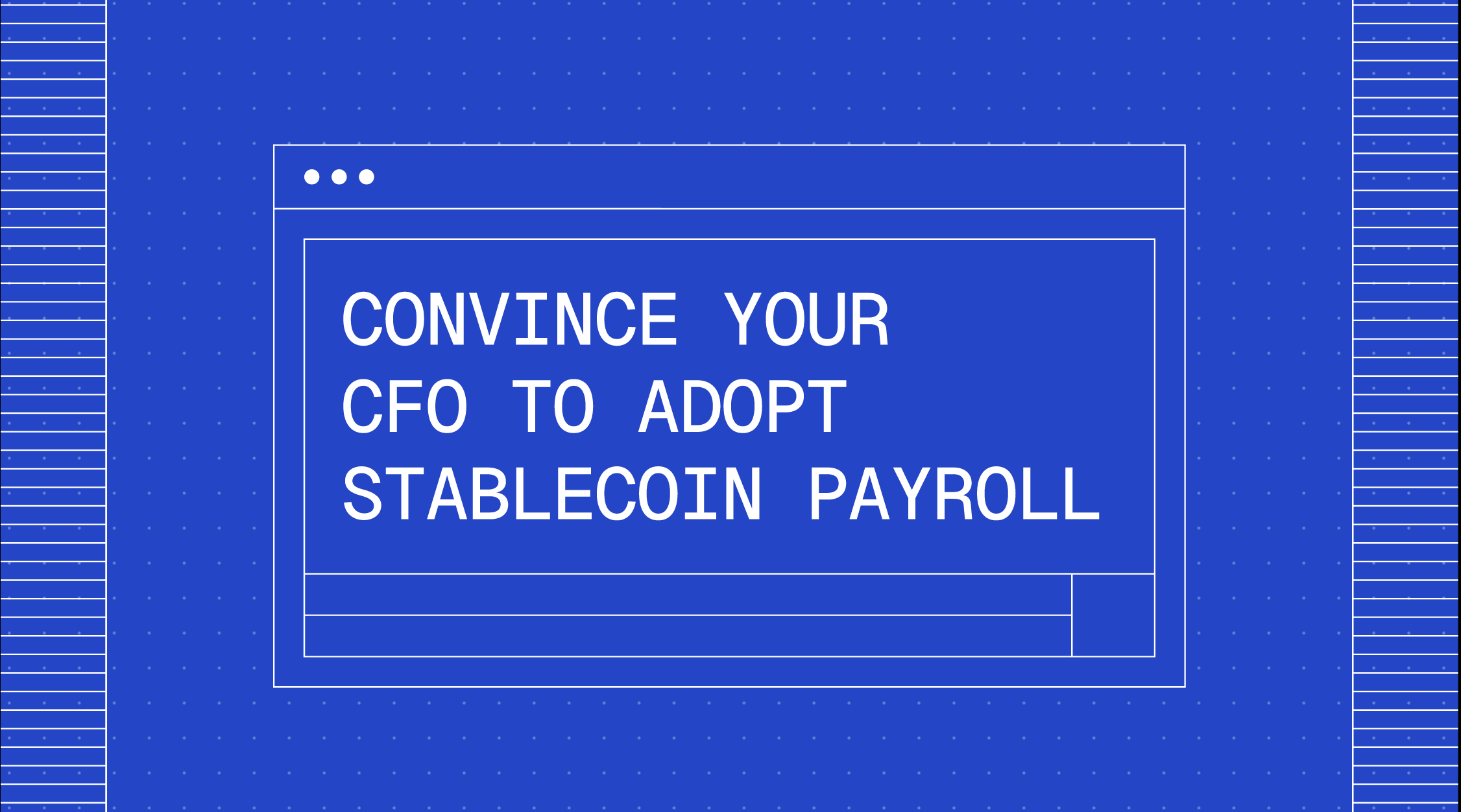
How to Convince Your CFO to Adopt Stablecoin Payroll | Guide
Convince your CFO to adopt stablecoin payroll using compliance-first arguments, cost reduction metrics, and a proven 7-day implementation plan.

.avif)
If you’re trying to move your organization to stablecoin payroll, the biggest obstacle isn’t technology, regulation, or contributor readiness — it’s internal alignment. Specifically, your CFO.
Not because the CFO is “against crypto.” But because their responsibility is to protect the company from financial, legal, and operational risk.
For most CFOs, stablecoin payroll sounds like:
- A potential compliance risk
- A reporting complication
- A volatility exposure
- A break from payroll continuity
- Something auditors will have questions about
Meanwhile, from your perspective, stablecoin payroll is:
- Faster settlement
- Lower FX fees
- Better experience for distributed contributors
- More predictable and transparent treasury flows
- A payroll system aligned with a global, async-first workforce
Both perspectives are correct. The difference is language, framing, and risk positioning.
If you pitch stablecoin payroll as:
“We should start paying people in crypto.”
Your CFO will — correctly — assume:
- You’re changing the nature of compensation
- You’re introducing risk to employment obligations
- You’re talking about tokens with price volatility
- You don’t have an answer for tax withholding or reporting
- This is going to create future audit pain
And the conversation ends immediately.
Understand the CFO’s Operating Framework
To convince the CFO, you must speak in their decision language, not yours.
A CFO is optimized for risk minimization, financial clarity, regulatory compliance, and predictable operations. Their job is to prevent surprises — not chase innovation for innovation’s sake.
So instead of arguing from speed or decentralization, you frame stablecoin payroll in terms of:
- Control
- Audit integrity
- Compliance certainty
- Cost efficiency
- Process reliability
The CFO needs to know one thing above all:
This will not create new financial or regulatory risk.
Everything you say must reinforce that point.
How a CFO Evaluates New Payroll Infrastructure
A CFO evaluates any change using four lenses:
If your explanation does not explicitly satisfy these four categories, the CFO will decline — not because the idea is bad, but because it is incomplete.
This is where most teams fail the conversation.
Why CFOs React Negatively to “Crypto Payroll” Language
If you use terms like:
- “Crypto compensation”
- “Paying salaries in tokens”
- “Let’s move payroll on-chain”
Your CFO will interpret it as:
- Compensation volatility exposure
- Possible employee misclassification
- Risk of non-compliance with wage laws
- Potential audit red flags
- Loss of predictability in reporting
They’re not wrong — that is a risk with unmanaged corporate token distribution.
So the language must be exact.
The Precise Language That Works
Use this framing:
- We are not changing how compensation is classified.
- We are not paying people in governance or utility tokens.
- We are simply shifting the settlement rail from slow, expensive banking infrastructure to stablecoins — while keeping all payroll taxes, reporting, and compliance exactly the same.
This does three things instantly:
- Removes the perception of “crypto risk.”
- Positions the change as operational modernization.
- Keeps the CFO in control — the CFO likes being in control.
When You Speak to the CFO, You Are Selling Risk Reduction
Not speed. Not convenience. Not culture. Not philosophy.
Risk reduction.
The CFO wants:
✔ Auditable transactions
✔ Standardized reporting formats
✔ Repeatable payroll execution
✔ No variance in tax or accounting treatment
✔ Cost efficiencies that are discrete and measurable
Stablecoin payroll provides all of those — if implemented correctly.
The keyword is not “stablecoin.” The keyword is controlled settlement infrastructure.
And that’s exactly what Toku provides.
Reframe Stablecoin Payroll as an Efficiency Upgrade
This section eliminates the instinctive resistance.
Stablecoin payroll is not a finance experiment — it’s a logistics improvement.
The Current Problem: Legacy Rails Were Designed for a Different Era
If your team has contributors across LATAM, APAC, the EU, the U.S., and Africa, your payroll currently looks like this:
- 3–7 day settlement delays for international wires
- 3–7% lost every cycle to FX spread
- Random delays caused by correspondent banks
- Payroll fragmentation across multiple regional vendors
- Contributors who don’t have reliable access to local banking infrastructure
This is not a theoretical inconvenience. This is real operational drag.
Payroll friction becomes culture friction.
Contributors start budgeting around uncertainty. Morale erodes. Trust degrades quietly.
You may not hear complaints — but you feel their effect in retention and velocity.
Stablecoin Payroll Removes the Bottleneck
Stablecoins don’t change pay. They change how pay moves.
This is standardization, not experimentation.
What CFOs Care About Here
Use this sentence when discussing efficiency:
Stablecoin payroll standardizes global salary payouts under a single settlement rail, while maintaining full tax withholding, payslip compliance, and reporting.
This reinforces:
- No change to regulatory responsibilities
- High increase in operational clarity
The CFO does not gain risk. The CFO gains control.
Anticipate and Neutralize CFO Objections Before They Appear
Your CFO’s pushback will be predictable. That means you can pre-solve it — before it surfaces.
Below are the exact objections CFOs raise, and the approved responses that disarm each one.
Objection #1: “Is this legally compliant in every country we operate in?”
Reality: Payroll laws vary by jurisdiction — but compensation paid in stablecoins is still taxed and reported the same way as salary. Nothing about stablecoins changes employment obligations.
Your Answer:
“Stablecoin payroll keeps tax withholding, employer contributions, and reporting exactly the same. The only change is the settlement rail. We will use Toku to handle compliance in 100+ countries, including payslips and local filings.”
Reinforce: Compliance is not changing — compliance is being automated.
Objection #2: “What about volatility?”
CFOs imagine “paying employees in tokens that fluctuate.”
You shut this down instantly:
Your Answer:
“We’re not paying in governance tokens or volatile digital assets. We use fiat-backed stablecoins like USDC, which track USD value 1:1. Compensation value is stable, predictable, and recorded at payment timestamp.”
Reinforce: No speculation. No token exposure. Fixed value.
Objection #3: “Will this complicate accounting or audits?”
This is the CFO’s deepest fear.
Your Answer:
“Every payroll transaction is timestamped on-chain, converted to local currency at the time of settlement, and exported directly into our accounting system. Toku provides audit-grade reporting and ledger mapping.”
Where legacy banking is opaque, stablecoins are transparent.
Objection #4: “What if payroll fails?”
CFOs think in disaster scenarios.
Your Answer:
“We run a full simulation payroll cycle before going live — no funds move. Once validated, execution is automated. There is no payroll downtime.”
Reinforce: This is a controlled transition, not a switch-over leap.
Objection #5: “Why change something that’s working?”
This is the inertia objection.
Your CFO is not saying “no.” They are saying: “Show me the business case.”
Your Answer:
“We are currently losing 3–7% to FX spread every global payroll cycle, plus wire fees and manual reconciliation overhead. Stablecoin payroll removes those costs and standardizes the process.”
Then show the math (next section).
The Cost-Control Argument (Your CFO’s Pressure Point)
This is where you win the conversation.
Because CFOs don’t approve new systems for cultural reasons — they approve them for financial reasons.
The Current Cost of Global Payroll (Hidden + Visible)
If you're paying $300,000 / month globally, a 4% FX bleed = $12,000/month lost.
That’s $144,000/year in silent waste.
Stablecoin payroll eliminates this entire loss.
How to Present This to the CFO (Copy This Line)
“We can turn payroll into a zero-FX, instant-settlement, globally standardized process, and remove up to 3–7% in recurring cost drag. The ROI is built into the payment rail itself.”
This is the language that gets approval.
Because CFOs don’t adopt technology. They adopt cost efficiency with managed risk.
Explain the Compliance Layer Clearly (This is Where Toku Wins)
The key to CFO alignment is demonstrating that the compliance layer is already solved.
You do not propose building it internally.
You do not propose legal research.
You do not propose reinventing payroll.
You point to Toku, which provides:
This instantly removes:
- Legal uncertainty
- Accounting friction
- Operational burden
- Implementation risk
This is the credibility anchor.
Without this step, the CFO will block.
With it, the CFO will approve.
The 7-Day Implementation Plan (This Closes the Deal)
CFOs need predictability, not theory.
Show them this:
This demonstrates:
- No undefined timeline
- No open risk surface
- No operational complexity
- Managed transformation
Your CFO will approve transitions that are:
- Clear
- Controlled
- Reversible
- Auditable
This is exactly that.
Ask Your CFO to Switch to Toku
Your CFO doesn’t need to become pro-crypto. They need to see that stablecoin payroll is safer, cheaper, more reliable, and fully compliant.
You now have:
- The CFO-ready narrative
- The risk-neutral framing
- The cost savings model
- The audit and compliance answer
- The implementation timeline
There’s only one step left: contact Toku.







